|
THEVIRTUAL
ORANGE DAY PARADE Continues...
On ye go now don't be dragging behind....Miss.
Please keep the little ones out of the roadway! Thanks...Ladies and Gentlemen
the Parade Continues! |
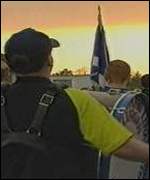  |
THE VIRTUAL ORANGE PARADE
PART THE
THIRD
Announcer:
Orangeism
is worldwide there are Orangemen of all colors and throughout the
world.
Peaceful
Orange processions occur everywhere.
generally
they are met with polite crowds....after
all....everyone
loves a parade! Let us go now to
Toronto
for one of the biggest!
The
Toronto Orange Parade A report on the
Toronto Orange parade, which is incidentally the oldest continuous parade
of any kind in North America - New Orleans Mardi Gras takes second place.
The parade was of course led by a mounted King William followed by Unity
Flute Band [Queens York Rangers]. Next came the colour guard of the
Metro Toronto Civic War Veterans, followed by County and Grand Lodge officers.
Then came a wave of Orange banners each of them separated by a band playing
Orange music. Some of the lodges taking part [you never see them all when
you're walking in the parade] were Highland Creek 2934, John Ross Robertson
2971, Victory 137, Port Perry 3272, Brampton 5, Eglinton 269, Temperance
301, Belfast Purple Star 875, Tobermore 2391, Torbay 361, Birchcliff 2856,
Garibaldi 3119, and Purple Hill 399. Bands included Unity Fife and
Drum, Cambridge Crown Defenders [flute], Ulster Accordian, Oshawa Flute
Band, Sons of William [flute], Sandhill Pipe Band, Derry Flute, Tecumseh
Fife and Drum. The crowds watching this year's parade seemed to be much
larger and they sure as hell were a lot friendlier. First year I
can remember for a long time that we didn't have a bunch of nutbars protesting.
The parade in Toronto has over the years become a cultural get-together
for those of an Orange family background here in Ontario. Every year
you meet people that you haven't seen since the last 12th and many people
travel for hours to attend. The odd thing here in Ontario is that
many people not connected with the Orange Lodge still consider themselves
Orange families. This isn't a slam at them, indeed its a compliment to
the hold that Orange tradition has kept on these people that for many years
haven't been connected to official Orangeism. Here in Ontario the Orange
Lodge is truly a cultural mosaic. Irish, Scottish, Canadian, Greek,
Italian, Polish, and even Chinese - Ho Pak, a Past Master of the Windsor,
Ontario Lodge, march together united in one common bond - the Protestant
faith. The parade is a shadow of its former self but continues to
be the brightest day on the Orange calendar for thousands of Ontarians.
-Alex Rough
ANNOUNCER: Next up its the
DANDENONG DEFENDERS INDEPENDENT
LOYAL ORANGE LODGE
ALL
THE WAY FROM DOWN UNDER! THE LODGE DRESSED IN DARK BLUE SUITS WITH RED
ROSES STAND OUT AGAINST THE BLUE SKY WHAT'S THIS? A HANDBILL THANKS LAD!
I WILL READ IT :
We
are an Orange Fraternity consisting of Ulster and Scots people , adherents
to the faith of the Reformation At present we are based in Melbourne ,
Victoria. The 36th Ulster DivisionThe
Battle of the Somme(July
1, 1916)(1998 Instructions) Parade to the Cenotaph starts at 1415 hrs.
from Pultney St -mel ref 90 E8 The Service is at 1500 hrs. in the Dandenong
Town Hall Lonsdale St. Dandenong Defenders is an Independent Orange Lodge
with no connection with the Loyal Orange Institution of Victoria. For more
details contact Secretary Eddie Simpson on 03 9 431 0749 or The Master
Ray Newall on 039775 7744
ANNOUNCER: ALL THE WAY FROM SCOTLAND
THE VIRTUAL UNIT OF THE
GRAND ORANGE LODGE OF SCOTLAND
QUITE VIRTUAL IN FACT!!
Go
visit them!
At last a banner!

And lead off by a very loud brass
band playing: You guessed it and freely in cyberspace! The Sash!
Go ahead sing along:Sing
Along!
Actually today Orange Order Processions
no longer play the traditional ballads of the time honored tradition. Bowing
to intolerant protests the order has changed many customs to suit
the more intollerant sectors of the community. Today religious hymns common
to all traditions are the only songs played. Orange parades are also striclty
policed ensuring that no objectionable behavior occurs. The processions
threaten no one.
ANNOUNCER: What would a celebration of the
battle of the Boyne be without the ritual battle
by the Black Preceptory. So move back ladies and
gentlemen and let the fun begin!
Old pretender's last fight King Billy bows out a winner in Scarva
By Gail Walke
IT WAS, let's
face it, unlikely to be a shock result. No ringside bookies laying
odds here. But
that didn't stop a tidal wave of anticipation sweeping through tens of
thousands of spectators at the first glimpse of the bitter arch-rivals.The
centuries fell away as kings William and James, on horse- back and
resplendent in costume, slipped through the trees and into the big field
for the sham fight at Scarva.
Grouped around them for moral support during this annual re- run of the
Battle of the Boyne were lieutenant generals
and gun-toting foot soldiers. In
the orange corner, so to speak, was Billy; in the
green corner - and looking surprisingly confident and unaware of the tragedy
to come - was James.
Suddenly the first shot rang out, smoke filled the air and the crowd surged
forward; in seconds we were all in the thick of battle.
Gunfire rained thick and heavy; the green standard came under brutal
attack. To be honest, though, some of its defenders didn't really
seem to have their hearts in the job.
Nevertheless, torn and tattered it hung on in there
anyway.
Then, just when it looked as if James was a goner, the
combatants split apart and headed up opposite sides of
the field with many of the crowd in hot pursuit.
They regrouped in front of a startled platform party where
this time the Catholic monarch had no escape.
"Go on, kick his ass when you have him down on the ground,"
roared one man as the defeated king staggered and fell.
Another, swept away by the imminent victory, shouted:
"Cremate him, where you have him." One little girl, however,
was fast losing enthusiasm for the battle royal. "He's not really dead,
daddy, is he?" she piped up. Her relief was tangible when, seconds
later, a
happy-looking James was hoisted to his feet.
I caught up with King Billy just after he dismounted. Wig in
hand and sweat on brow he had some devastating news to deliver -
his own abdication.
Glancing around and lowering his voice, his alter ego Trevor Whitten revealed:
"That was my last one. I'll not be back." The Scarva man admitted
that, contrary to appearances, the showdown had been
a close run thing.
Indeed, it could have been history in the unmaking.
"I nearly slipped out there and it wouldn't take me to go down.
"It's a younger man's job. I've done it more than 10 years
but no more," he said, shaking his head at the unthinkable defeat.
King James, aka John Adair from Scarva, was philosophical about his trouncing:
"Let's just say, after all these years, you get used to it." Meanwhile,
an international photographer was snapping away feverishly.
"Does this make you all feel like a war correspondents?"
he asked. We all hoped he was joking. (Though it was about then that I
noticed I had been
shot...in a manner of speaking. Fall-out from one of the cartridges
had singed a neat hole in my shirt.) Another overseas visitor
who relished every minute of the
spectacle was Richard Atchoe, a member of the Black
Preceptory from Ghana. "I love the whole atmosphere," he
enthused. "The unity of it all." He was poised to reply
to my question of how he became a Blackman when 77-
year-old Bert Atwell interrupted: "If a black man can't join
the Black Preceptory." I never got my answer because
they all collapsed in fits.
Mr Atwell, also a Blackman and originally from nearby
Tandragee, had travelled from Johnstone, in Scotland. "I
wouldn't miss it. Never." Some of the other 80,000 visitors yesterday
hailed from the USA, New Zealand,
Toga, Scotland, England, the Republic and Australia.
They thronged the village and lined the route to the
demense at Scarva House, where the event takes place.
Many people I spoke to commented on the great carnival atmosphere,
which they felt had been missing from this year's Twelfth.
In fact, the only near disaster came just before the
platform address. An oil painting of Lord Molyneaux being presented
by the Preceptory to its Sovereign Grand Master
to mark his elevation to the Upper House was suddenly
blown off its easel by a gust of wind.
The relief of the faces of the men who retrieved it and
discovered it was still intact was comparable only to
that of King Billy, when he regained his balance and saw
victory in his sights.- (From the Belfast Telegraph 7/15/97)
Lets listen in as an older Orangeman
is talking to his teen age grandsons about what the 12th means to
him: Harold Rutherford Alexander is an Ulster-American who
was born in Belfast. He emigrated
to the USA in 1963. He holds
degrees from Queen's University,
Belfast, Trinity College, Dublin,
and Columbia University, New York.
He is President of the American
Association of Orange
Societies and has served as Grand Master of the
Loyal Orange Institution
of the USA. Here is what he had to say:
"The Twelfth of July is one among
the many national
holidays of the western world.
In the United States we celebrate our
independence on the Fourth
of July, in France the fall of the Bastille
on July 14 is the focus of national
rejoicing, and in Mexico the
Cinco de Mayo evokes patriotic
and national sentiment. The list
goes on but these few examples
will suffice. The people of Ulster, both
at home and throughout the world,
celebrate the Twelfth. These
national holidays are occasions
of remembrance, thanksgiving, and
reaffirmation. They are marked
by military and other parades, religious
processions, fireworks displays,
and dancing in the streets. Our
celebration of the Twelfth has
all of these. However, the Twelfth
has for many a more private and
personal meaning.
In 1690 the Glorious Revolution
had taken root in
England, but in Ireland this was
not so. James II, the deposed King
of England, had gone to Ireland
as a step toward reclaiming the
throne. He was welcomed by
the Gaelic chieftains who saw the
possibility of completing the genocide
that had almost succeeded in
the 1640s. If the Battle
of the Boyne on the Twelfth of July, 1690,
had gone differently, I would not
be here today. It is often
said that the Battle of the Boyne
was a minor skirmish in a major
European war, and that the forces
arrayed against James, and his patron
Louis XIV of France, would
have eventually prevailed even if the
Boyne had been lost. However,
it was a major event for the small
farmers and settlers in Ulster.
If the outcome at the Boyne had
been different, the Irish tribes,
reinforced by the professional
armies of France, would have had
months or even years to uproot the
Ulster plantation, to kill the
settlers or drive them into the sea. If
that had happened, neither I nor
my wife would exist today.
I mean that quite literally.
Even if our forebears
had managed to escape death, the
complex web of relationships, which
has produced me as a unique person,
would have been ruptured again and
again. In Ulster, after the
Boyne, the small farmer, tradesman,
or artisan could go to bed at night
and be reasonably sure that he and
his family would not be murdered
nor harried from their homes before
dawn. The Ulster community
could now develop its own unique national
character and it would later
provide the United States and other
countries with the flow of
settlers, pioneers and immigrants which
continues to this day. In the history
of the United States the Scotch-Irish
are recognized as a distinct national
group whose imprint is evident on
all the institutions of the nation.
Without the Scotch-Irish
(the name by which
Ulster-Americans or Orange-Americans are known)
the United States would have evolved
quite differently.
The Scotch-Irish were the first
to defy the British ban on settlement west of the Appalachians
by setting up the Republic of Transylvania
in what is now Kentucky and Tennessee. They were the
first to declare independence from
Great Britain at Mecklenbury, North
Carolina, in May 1775, more
than a year before the Declaration in
Philadelphia in July1776.
In 1836, they prevailed against another empire when they
rebelled against Mexican tyranny
to found the Republic
of Texas. The climactic moment
of this struggle was the massacre of
the Scotch-Irish defenders at the
fall of the Alamo. In my heart I
know that the pioneers who died
at the Alamo were inspired by folk
memories of the Siege of Derry.
These are some of the things upon
which I reflect when
I assemble with my brethren on
a bright summer morning in July. Above
all I revere the memory of
that small, chronically ill figure,
Prince William of Orange, and I
am awed by his miraculous escape from
death at the Boyne when the cannon-ball
inflicted a wound that was less
than mortal. I give thanks
for the Divine Providence that saved his
life, thereby setting in motion
the tide of history that has
sustained and prospered the Ulster
people until today."
|
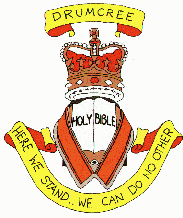
Don't Just Talk About It!
Know About It!!
Get the information about
Drumcree directly from the source!
Click
Here and be Accurately Informed. For direct breaking news
updates Click
Here
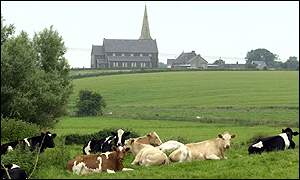

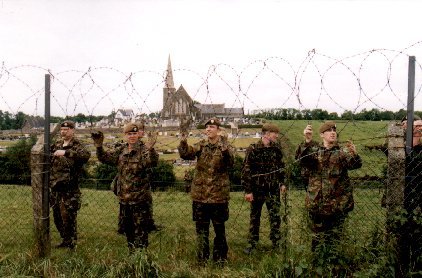
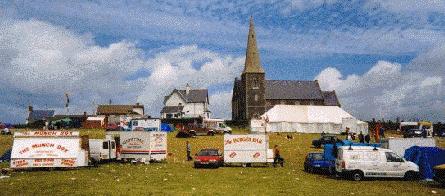
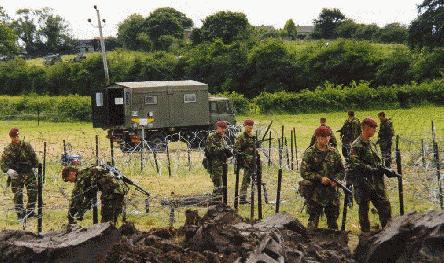
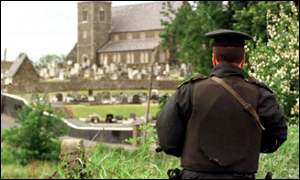

|
ANNOUNCER:
YES LADIES AND GENTLEMEN BELIEVE IT OR NOT RIGHT FROM PORTADOWN ITSTHEEXTREMELY
DIGNIFIEDAnd Legal, and Peaceful!PARADE ALONG THE GARVAHY ROAD
1997! TRANSPORTED TO CYBERSPACE!!!! YOU WILL FIND NO PROTESTS AND NO
RE ROUTINGS HERE! NO QUESTIONS ABOUT MARCHING RIGHTS OR ANY OTHER

It was a fairly humid morning as
members of Portadown District gathered in the town's Carleton St at around
10am. News had been coming in that the security forces had cleared the
Garvaghy Rd and were preparing to seal the road off completely so that
the Orangemen could make their way along their traditional route from Drumcree
church. The only other people visible in the street were the press who
were roaming around like vultures at times in the hope of picking up anything
which may discredit the Institution. The
brethern were very subdued as they waited to be addressed by the Worshipful
District Master and set of to Drumcree parish church. Most of the brethren
were of the opinion that the Chief Constable had for once taken the right
decision regarding the parade and also that the nationalist backlash organized
by Sinn Fein/IRA could be a militant and bloody one. The condemnation which
was to follow the parade from the Secretary of State for Northern Ireland
was in complete contrast to the views she expressed at a meeting in Brownlow
House on Friday night. During this she acknowledged that SF/IRA were behind
the residents groups and that the Orangemen were the ones who had suffered
in the past. The compromise offered
to the Orangemen was that if they didn't walk the road they MAY be given
an opportunity to walk it at a time in the future hopefully this year.
On the other hand the final compromise offered to the SF/IRA resident's
group was a twelve million pound investment into the Garvaghy Rd area if
the parade was allowed to pass. As
the parade set off into the town centre it was clear that a large crowd
had gathered to watch the Orangemen accompanied by two bands. The parade
turned back on itself in the town centre as it passed Woodhouse St where
it had been re -routed from in the mid-eighties, a promise at the time
by the then Chief Constable Jack Hermon regarding the surety of walking
down the Garvaghy Rd had been broken in the past two years. As the walk
proceeded past the Edgarstown area a large crowd had also gathered, the
Orangemen again remained stone faced except when to acknowledge relatives
and the like. A banner at the side of the road read "There are no Nationalist
areas in Portadown, just ones temporarily occupied" which gave a hint at
the depth of feeling from the loyalist people of the town. The parade passed
Clonavon Ave where a lone republican taunted and hurled abuse at the passing
procession in the hope that the media would catch a walker stepping out
of line, this street had seen ethnic cleansing of Protestants over the
last decade. The parade then headed past Corcrain Orange hall which although
still flew the union flag, had even more republican graffiti on it. The
hall had been burned severely a few years before as SF/IRA tried to push
Protestants completely from this area. The
long route to the church finally passed the chapel at the end of the Garvaghy
Rd and the church was only another mile or so away. At this point there
was an extensive police, army and media presence, the Orangemen again remained
dignified and resolute. After
reaching the church and before entering the church the Orangemen queued
for cups of water as the especially long route in the humid weather had
taken it's toll, particularly on older members. Then the Orangemen attended
the service which lasted for around an hour with all the brethren not able
to gain entry to the church or the hall. When
the service was over the Brethren were again addressed by the WDM and after
this, proceeded to form up in rows of six with only one of the bands to
return. The return parade passed
off without incidence until it turned into the Garvaghy Rd where it was
met with one of the largest security presence I have ever seen. The Accordion
band had stopped playing and all that could be heard was the abuse and
taunting from some residents. Orangemen again refused to be drawn from
their serious yet bemused expressions. The
hatred for all things Protestant was clear for everyone to see on the faces
of the republicans as further on down the road they made as much noise
as possible which may have been to try and intimidate the Brethren. Three
new murals had been painted recently and sectarian banners and foreign
flags flew all around as the lone union flag, the Orange standard and the
Portadown bannerette moved as quickly and respectfully down the road as
possible. Some of the soldiers looked young enough still to be at school
and seemed a bit surprised at what the whole fuss was about. Debris still
lay on the road from the rioting the night before and RUC men were clad
in what seemed to be navy fire resistant suits. Republicans tried to assault
members of the security forces and indeed fired a limited number of missiles
into the procession. Further
on down the road the parade passed what used to be unionist area but due
to ethnic cleansing by SF/IRA the only Protestants who live their now are
older ones who had come out onto the street to show their appreciation
to the Brethren. Just before the Carpet factory and Parkmount Arch a group
of people had gathered at Woodside Green to publicly display their hatred
for all things not associated with nationalism. They hurled a few missiles
into the parade but again the brethren remained dignified. The media again
were no where to be seen as they only wished to take pictures of the brethren
in case anyone stepped out of line. After
the parade passed through large crowds from Shillington's to Carleton St
the parade ended and already word was coming through of orchestrated attacks
and rioting by SF/IRA in certain republican blackspots in the province.The
aftermath, well the full extent of this has yet to seen but the real burning
question that many Brethren would like answered is "What exactly is offensive
about this parade?
The Year is now 1998 and a peaceful march along a traditional
route was stopped by a government who responded not to safeguard civil
rights but to appease a mob of republicans,catholics and nationalists who
threatened the peaceful, legal, non threatening and traditional marchers
with violence.
Why can't republicans, nationalists, and catholics extend
civil rights to their fellow citizens? A peaceful march threatening no
one, harming no one could have occured with peaceful protest and been done
with. But the community of violence had their way and this is now the sad
scene:
Having a field day at Drumcree
'We will walk Garvaghy Road'
By Dan McGinn and Claire McGahan
IT could
have been any Twelfth field.
Couples
draped in Red Hand flags and wearing Union Jack caps pushed prams as they
picked their way through the market stalls selling Orange memorabilia.
Old men
in collarettes looked on as families stood around barbecues or picnic
baskets with Coke bottles, flasks of coffee or cans of lager in their hands,
waiting to dole out food to their children.
Others
were taking it easy in their cars or in the field, sitting
or lying on newspapers to shield themselves from the damp in between
sporadic bursts of rain.
The sound
of distant flutes and lambeg drums carried over the sloping
Co Armagh countryside.
But a
gaze across the field at the lines of barbed wire, the trench, the
armoured cars and the soldiers crouched across
the barricades
soon shattered any illusions.
This was
no ordinary Twelfth.
Drumcree
had entered its ninth day.
For Portadown
Orangemen, it was business as usual, despite
the pressure on them to call off their protest in the wake of
the triple murder of the Quinn children in Ballymoney.
The day
had had a low-key start.
The numbers
staying overnight had dwindled to their lowest since the stand-off
began more than a week ago.
Only around
200 people awoke to face the day of traditional Twelfth marches.
In the
uneasy quiet, it was possible for the first time during
this crisis to hear the gentle hum of electricity generators -
previously drowned out by the roar of the crowd, the banging
of Lambeg drums, fireworks exploding and the sound of plastic bullets.
Men and
women emerged from cars, tents and caravans into the sunshine clutching
towels, toothbrushes and kettles. The aroma of toast wafted through the
air.
As the
day wore on, there was a steady flow of Orangemen and their supporters
to and from the site, with some people arriving fresh from their
local Twelfth demonstrations.
A mini-Twelfth
parade was staged mid- morning, with hundreds of Orangemen
marching behind the Star of David Accordion Band to the church and
the Army barricade
before
dispersing.
However,
the numbers were still smaller than in previous days.
Orangemen
insisted the depleted numbers were due to
people
returning to their own areas to prepare for their local
Twelfth
celebrations.
The real
acid test of continued support would be in the
evening
when the Twelfth demonstrations across the
province
ended.
Addressing
the crowd, Portadown District Master Harold
Gracey
paid tribute to Orangemen from outside the town
who had
come to support them in recent days.
"I personally
thank you for that support and would ask for
your continued
support until the end of this struggle.
"I know
it is there. We are expecting brethren tonight from
the Lurgan
demonstration and I know that the Coleraine
District
is definitely coming." Rumours circulated among the
crowd
that DUP leader, the Rev Ian Paisley, would appear
again
at the church in solidarity with the Portadown
Orangemen.
However,
most of the conversation centred on the events of
the weekend
and the pressure being exerted from within the
Orange
Order, from Stormont and the British Government
for them
to call off their protest.
One man
said the appeal from the pulpit from the Rev
William
Bingham for them to end their stand-off, and his
claim
that any march down Garvaghy Road would be a
"hollow
victory", was unwelcome to many gathered at
Drumcree.
"The Rev
Bingham does not speak for the rank and file
people
who are here and who are prepared to stay here until
we get
our right and get to walk back to Carleton Street by
the Garvaghy
Road," he said.
"Our resolve
is still strong. We will walk the Garvaghy Road.
What was
right yesterday and the day before is still right
today.-Source-Ulster
News
For photos of the 2000 protests
and brutal police action to deprive rights
click
here

"Somewhere I read
of the freedom
of assembly. Somewhere
I read of the
freedom of speech.Somewhere
I read
of the freedom of
the press. Somewhere
I read that the greatness
of America is
the right to protest
for right.And so just
as I say, we aren't
going to let any
injunction turn us
around. We are going on."
(Martin Luther King - "I see the
Promised Land"
speech in Memphis)
The Year is
2000 Will the Orange Order Go into
the Next Century with their
Basic Rights denied?
Watch This Space!
|
A Horrible reminder of the intollerance which still meets the Orange
order as it peacefully parades and goes about its business is the act of
arson which consumed the Moree Orange Lodge.
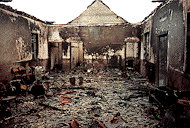
Please consider stopping by the Moree Lodge Page to assist this lodge
in recovering from this terrible disaster to go to Moree Lodge click
here
I hope that these pages have
provided you with a view of Orange Processions which is more positive than
that provided by the media. In any case I recommend that you vist the web
pages of the Grand Lodge of the Orange Order to receive important official
information.
Grand Lodge of Ireland Visit
Goli!
A few closing songs:
Click
for #2 Sing Out Loudly!
Click
for #2 Join in!
To Visit the Largest Collection
of Orange/Unionist Songs on the web click
here
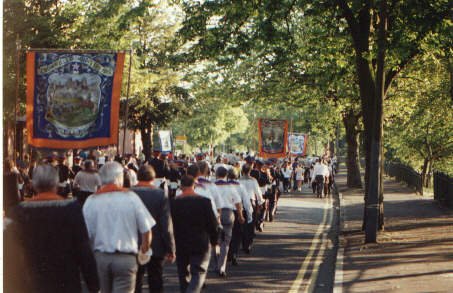
The Virtual Parade is made possible through a
generous grant of time and talent by HUTMAN PRODUCTIONS
CLICK HERE TO
FIND OUT ABOUT HUTMAN ....We make important
web pages!!!!
Thanks for taking the time to
explore the traditions of the parade. To collect the rest of the parade
go to :
Return
to the main parade page
For more information contact:
For
The Battle of the Boyne Pages!
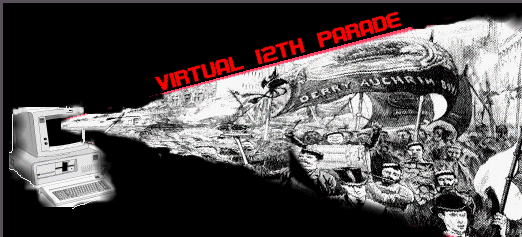
|















